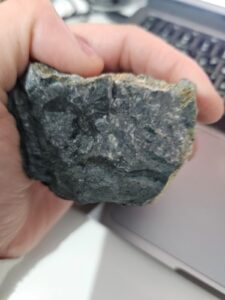Alphamin Resources (TSX.V: AFM), a tin producer in the DRC, and Nvidia (NVDA: NASDAQ), an American artificial intelligence company, are an unlikely pair. Yet, they are intrinsically linked through the critical role of tin in the technology sector. Over the past four years, both companies have experienced remarkable growth, driven by the increasing demand for advanced electronics and AI technologies. Nvidia, a leading player in the GPU market, relies heavily on tin for soldering components in its powerful processors. Alphamin, on the other hand, has solidified its position as a top tin producer, ensuring the supply of this essential metal. Therefore, the continued expansion of both businesses underscores the crucial role of tin in technological advancements. Simply put, believing in Nvidia’s, and its competitors, growth prospects requires acknowledging the crucial importance of a thriving tin market.

The growing demand for tin in AI and technology
Tin demand is driven by its crucial role in electronics, used as a solder for joining components on circuit boards. According to the International Tin Association (ITA), approximately 50% of the world’s tin consumption is attributed to soldering applications. This demand is expected to surge as the global semiconductor market continues to expand. Fortune Business Insights projects the semiconductor market to double by 2029 to $1.3 trillion, significantly boosting tin demand.
Additionally, the transition to electric vehicles (EVs) and renewable energy technologies is expected to further drive tin consumption. EVs use three times more tin than traditional internal combustion engine vehicles. This is due to the increased complexity and number of electronic components. The solar photovoltaic market also heavily relies on tin. Tin is used as a solar ribbon to connect solar cells within panels. The ITA predicts that the use of tin in solar energy will double by 2030.
Chart 1: Demand for refined tin expected to exceed 515,000 tonnes by 2030 -Source: Andrada Mining
Supply constraints and price volatility
Despite the growing demand, the tin market faces significant supply constraints. The World Bank’s Commodity Outlook highlights that the metal’s prices increased by 7% in Q1 2024. This was driven by supply disruptions in major producing countries, like Myanmar and Indonesia. Myanmar’s Wa State controls one of the world’s largest tin mines and is a significant source of uncertainty. Its mining operations have faced ongoing suspensions and regulatory challenges, leading to reduced output and heightened market volatility.
Indonesia, another major tin producer, has also experienced disruptions due to delays in mining approvals and export licensing. These supply constraints have contributed to elevated tin prices, which reached almost $31,000 per tonne in April 2024. Tin is currently trading at $33,500 (LME, 12 July 2024). Although prices have fluctuated, analysts expect them to remain high due to ongoing supply challenges and increasing demand.
These supply concerns highlight the need for reliable producers. Since its maiden production in 2019, Alphamin has shown consistency in its supply, increasing production levels, development of its resources and expansion of its life of mine.
Technological advancements driving AI growth
The rapid growth of artificial intelligence (AI) and advanced computing technologies will drive tin demand over the foreseeable future. AI applications require powerful GPUs, which in turn depend on tin for soldering and protecting components within printed circuit boards. Until ChatGPT’s advent, it wasn’t clear that AI would become mainstream. However, with its widespread adoption, it is clear that AI, and the associated need for more components, will be significant.
Companies like Nvidia, dominating the data center GPU market, will increase their tin demand as AI technologies proliferate.
For instance, OpenAI’s ChatGPT utilizes around 10,000 Nvidia GPUs for training, exemplifies the scale of tin usage in AI infrastructure. As AI models become more complex and widespread, the need for GPUs—and consequently tin—will continue to rise. This trend underscores the importance of securing reliable tin supplies to support technological advancements.
Emerging AI applications in battery technology
Beyond AI, tin is making strides in battery technology. Recent research on tin anodes for sodium-ion batteries highlights a promising new application for tin. Leading experts from UNIGRID and Nanode Battery Technologies showcased advancements positioning tin as key in next-generation sodium-ion batteries (SIBs). This offers a compelling alternative to lithium-ion batteries (LIBs).
Dr. Darren Tan from UNIGRID emphasized that tin anodes exhibit high specific capacity, excellent recyclability, and superior conductivity. Compared to conventional hard carbon anodes, they perform better. Bing Cao, CEO of Nanode Battery Technologies, detailed the advancements in rapid charging tin anodes, achieving a remarkable 94% capacity retention after six-minute extreme fast charging and discharging cycles. These breakthroughs address critical limitations of current battery technologies, paving the way for faster, more efficient energy storage solutions.
Chart 2: Electronic Solder is expected to account for the lion’s share of tin demand -Source: Andrada Mining
Alphamin’s role and expansion
Alphamin (TSX.V: AFM) simply can’t grow fast enough to meet the surging demand. Prior to Alphamin taking over the project, the Mpama ridge area was rumored to have once produced around 10% of the global tin supply through local informal mining. Currently, Alphamin’s Mpama North mine contributes around 4% of global supply and now with Mpama South in production, the company represents 6.5% of global production. Moreover, with further industrialization, it is highly likely that Mpama will be able to reach and exceed 10% once more. Exploration of Mpama South, just 750m away from the current operation, has yielded impressive results, and Alphamin has engaged in expanding the current separation plant in preparation for increased throughput.
Alphamin has successfully commissioned the Mpama North mine, which boasts the highest-grade tin in the world at 4.5% average grade. Now, with the commissioning of Mpama South, Alphamin’s tin production is expected to rise from 12,568 tonnes to 20,000 MT annually, generating significant free cash flow for the company. The combined plant output capacity is set at 25,000 tonnes of contained tin per annum.
On the 14th May 2024, the new Mpama South processing facility was switched on, and has been producing saleable tin concentrate ever since. This milestone comes just over two years after Alphamin declared the maiden Mineral Resource Estimate and Preliminary Economic Assessment for Mpama South in March 2022. The facility produced 159 tonnes of contained tin from May 17, and is now operating at targeted recoveries. On the 10th of July the company released an updated Q2 production report stating that the new plant outperformed during Q2 and achieved recoveries in excess of 70% at an average feed grade of 2,2%. This new processing capacity will significantly bolster Alphamin’s position in the global tin market.
Investment exposure to the tin market
Given the favorable market dynamics, companies like Alphamin Resources, that are involved in tin mining and production, offer substantial portfolio growth potential. The Company’s focus on high-grade tin deposits and efficient production processes makes it a compelling choice amongst notable portfolio managers and institutional investors, including Eric Sprott, Rothschild & Co. Asset Management SCS, Traxys and CATAM Asset Management AG.
Future opportunities in the tin market
The tin market is on the cusp of significant expansion, driven by robust demand from the electronics, renewable energy, and AI sectors. Supply constraints in major producing regions have further exacerbated the upward pressure on prices, creating an attractive environment for investors. Companies like Alphamin Resources are well-positioned to capitalize on these trends, making them worthy of consideration for those looking to gain exposure to this market.
As the world continues to transition towards more sustainable and technologically advanced solutions, the demand for tin will only grow. This presents a unique opportunity to participate in the evolving market dynamics and benefit from the long-term growth prospects of tin. The interconnection between Nvidia and Alphamin Resource underscores the essential role of tin in the modern technology landscape, shaping the industry’s future through their synergistic relationship.






